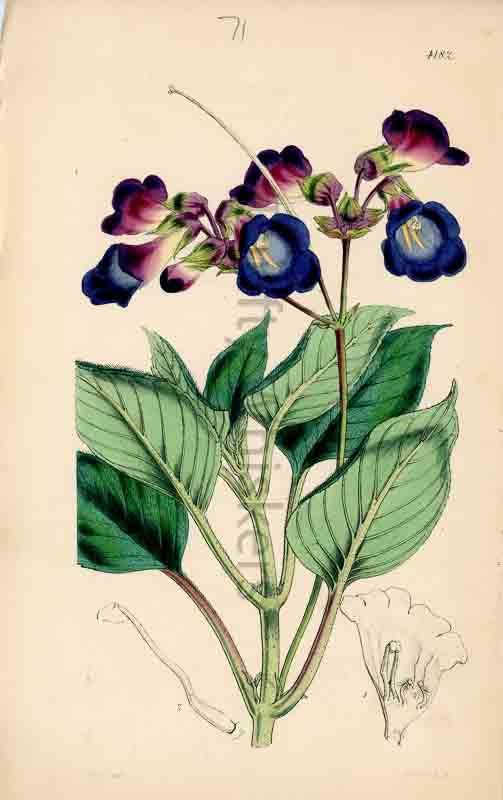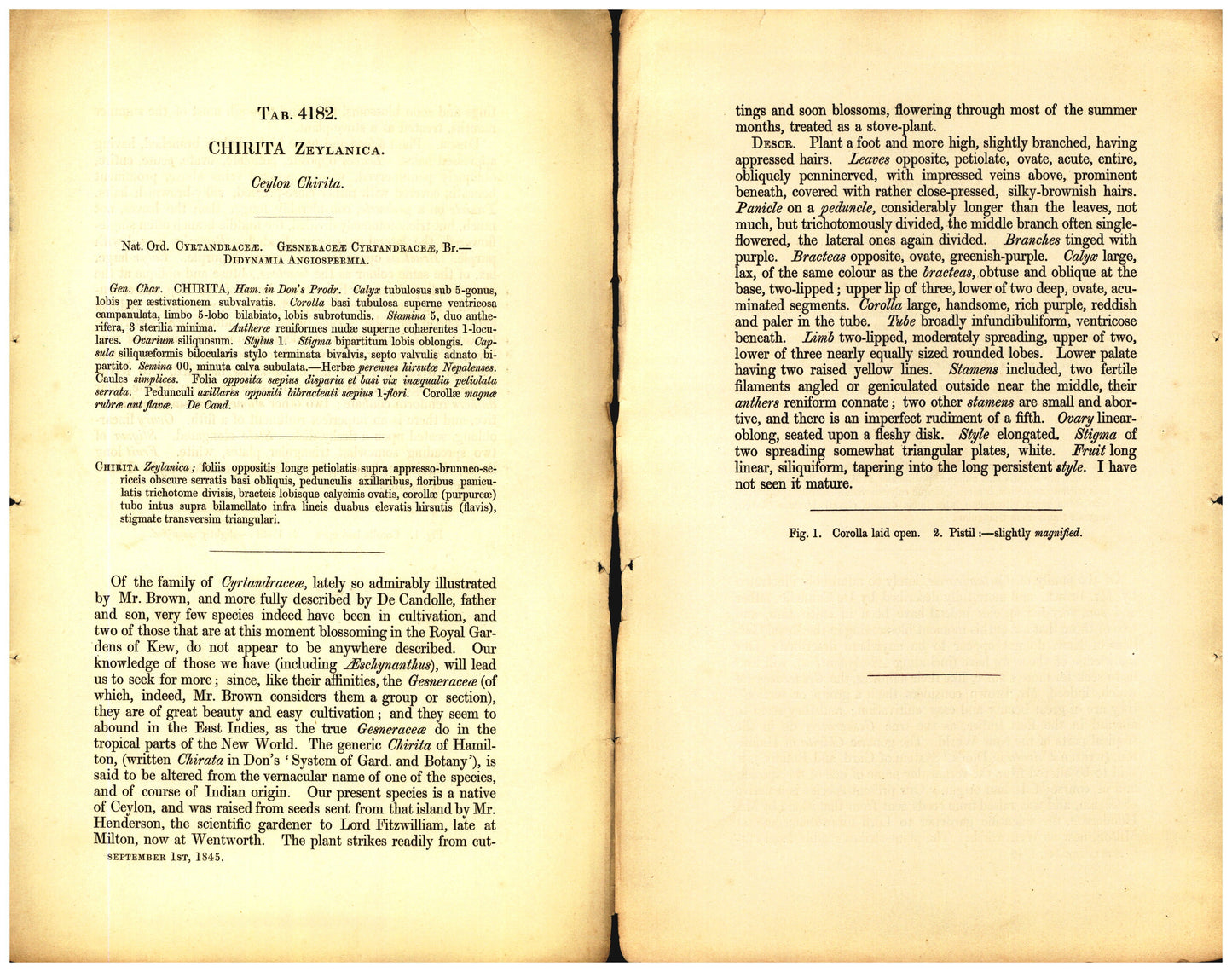Thrifty Whiskers
Plate 4182 Hand-Colored Botanical Print - Digital Download
Plate 4182 Hand-Colored Botanical Print - Digital Download
Couldn't load pickup availability
This is a high-resolution digital download of Plate 4182 from Curtis's Botanical Magazine. The original illustration was hand-colored in the 1800s. This listing includes both the botanical image and its accompanying description tab.
Perfect for art collectors, interior decor, or historical enthusiasts. No physical item will be shipped.
TAB. 4182.
grival babad CHIRITA ZEYLANICA. Ceylon Chirita.
Nat. Ord. CYRTANDRACEÆ. GESNERACEÆ CYRTANDRACEÆ, Br.- DIDYNAMIA ANGIOSPERMIA. In bus ca
Generic Character CHIRITA, Ham. in Don's Prodr. Calyx tubulosus sub 5-gonus,
lobis per æstivationem subvalvatis. Corolla basi tubulosa superne ventricosa campanulata, limbo 5-lobo bilabiato, lobis subrotundis. Stamina 5, duo anthe- rifera, 3 sterilia minima. Antheræ reniformes nude superne cohærentes 1-locu- lares. Ovarium siliquosum. Stylus 1. Stigma bipartitum lobis oblongis. Cap- sula siliquæformis bilocularis stylo terminata bivalvis, septo valvulis adnato bi- partito. Semina 00, minuta calva subulata.-Herbæ perennes hirsute Nepalenses. Caules simplices. Folia opposita sæpius disparia et basi vix inæqualia petiolata serrata. Pedunculi axillares oppositi bibracteati sæpius 1-flori. Corollæ magna rubræ aut flava. De Cand. pool lin owl CHIRITA Zeylanica; foliis oppositis longe petiolatis supra appresso-brunneo-se- riceis obscure serratis basi obliquis, pedunculis axillaribus, floribus panicu- latis trichotome divisis, bracteis lobisque calycinis ovatis, corollæ (purpurea) tubo intus supra bilamellato infra lineis duabus elevatis hirsutis (flavis), stigmate transversim triangulari. tings and soon blossoms, flowering through most of the summer months, treated as a stove-plant.
Botanical Description Plant a foot and more high, slightly branched, having
appressed hairs. Leaves opposite, petiolate, ovate, acute, entire, obliquely penninerved, with impressed veins above, prominent beneath, covered with rather close-pressed, silky-brownish hairs. Panicle on a peduncle, considerably longer than the leaves, not much, but trichotomously divided, the middle branch often single- flowered, the lateral ones again divided. Branches tinged with purple. Bracteas opposite, ovate, greenish-purple. Calyx large, lax, of the same colour as the bracteas, obtuse and oblique at the base, two-lipped; upper lip of three, lower of two deep, ovate, acu- minated segments. Corolla large, handsome, rich purple, reddish and paler in the tube. Tube broadly infundibuliform, ventricose beneath. Limb two-lipped, moderately spreading, upper of two, lower of three nearly equally sized rounded lobes. Lower palate having two raised yellow lines. Stamens included, two fertile filaments angled or geniculated outside near the middle, their anthers reniform connate; two other stamens are small and abor- tive, and there is an imperfect rudiment of a fifth. Ovary linear- oblong, seated upon a fleshy disk. Style elongated. Stigma of two spreading somewhat triangular plates, white. Fruit long linear, siliquiform, tapering into the long persistent style. I have not seen it mature. Thrifty whiskers Of the family of Cyrtandracea, lately so admirably illustrated by Mr. Brown, and more fully described by De Candolle, father and son, very few species indeed have been in cultivation, and two of those that are at this moment blossoming in the Royal Gar- dens of Kew, do not appear to be anywhere described. Our knowledge of those we have (including Eschynanthus), will lead us to seek for more; since, like their affinities, the Gesneracea (of which, indeed, Mr. Brown considers them a group or section), they are of great beauty and easy cultivation; and they seem to abound in the East Indies, as the true Gesneraceae do in the tropical parts of the New World. The generic Chirita of Hamil- ton, (written Chirata in Don's 'System of Gard. and Botany'), is said to be altered from the vernacular name of one of the species, and of course of Indian origin. Our present species is a native of Ceylon, and was raised from seeds sent from that island by Mr. Henderson, the scientific gardener to Lord Fitzwilliam, late at Milton, now at Wentworth. The plant strikes readily from cut- SEPTEMBER 1ST, 1845.
Figures
Fig. 1. Corolla laid open. 2. Pistil :-slightly magnified.
Share





